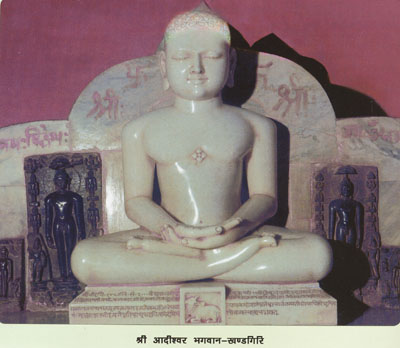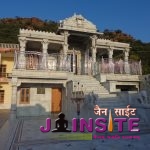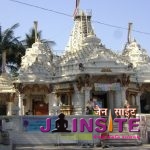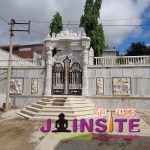SHRI KHANDHIRI TIRTH

Presiding Deity and Location :
Shri Adishvar Bhagwan in white color, seated in a lotus posture in a shrine which from Bhuvaneshvar is 6Kms away on a hillock 37 meters high known as Khandgiri (Dig).
ANTIQUITY AND SALIENT FEATURES :
History of this place starts from the period of Shri Adhishvar Bhagwan who divided Bharat into 52 sections calling each a Janapad. This area formed a part of one such Janapad known as Kaling Desh. Bhagwan Sri Rishabhdev (Adinath,Adhishvar),Sri Parshvanath Bhagwan and Sri Mahavir Bhagwan visited this area on several occasions out of whom, the name Sri Parshvanath continues to ring in the ears of local people. Those who believed in animal sacrifice etc., were even prohibited to enter this area. Vedic people called this area as Anarya Desh. In ancient times, this area was known by the names of Khandagiri, Mount Udaygiri , Kumaragiri, Kumarigiri etc.,
After hagwan Parshvanaths period, king Karakandu ruled here and he was a staunch follower of Jain religion. His kingdom included whole areas of Anga, Banga, Kalinga, Chera, Chola, Pandya,Andhra etc., He had defeated the kings of Chera, Chola, Pandya in battles but when he came to know that these rulers were wearing in their crowns signs of Jinendra Bhagwan he embraced them with a surge of affection.
In “Uttaradhyayan Sutra” are found references of Panchal King Dwimukha, Videha kings Nemi, gandhar king Nagnajita and Kaling king Karakandu. The last one is even believed to be a disciple of Phagwan Sri Parshvanath.
Every nook and corner of Kaling Desh was illuminated by the light of Jain religion through discourses by Sri Bhagwan Mahavir. There is one reference available which states that on Mount Kumari, a Samosaran of Bhagwan Mahavir was held. In this way the religion of Jainism which had spread considerably during the period of Sri Parshvanath, became the religion of all common people during the period of Bhagwan Mahavir.
Inscriptions have been found to the effect that Maharaja Shrenik (Bimbisar) had directed construction of a temple on this mount Kumari, got the golden icon of Sri Adhishvar Bhagwan installed after sanctification ceremony performed for such installation at the hands of Bhagwan Mahavir’s disciple Sri Sudhamaswami and had also directed making of several caves for Sadhus and Sadhvis. These inscriptions further state Sri Kunik, son of Maharaj Shrenik got 5 caves made out of these mounts.
60 years after ‘Nirvana’ of Sri Mahavir Bhagwan, king Mahapadmanand of Magadh Desh invaded this territory of Kaling Desh and having won carried away the golden icon of Sri Adhinath Bhagwan to his capital city, Patliputra. This Jain icon was accepted as the national icon in Kaling Desh and therefore when it was thus carried away, the entire population of Kaling sustained a shock which was both rude and deep. Emperor Ashok again invaded Kaling but this was 244 years after ‘Nirvana” of Bhagwan Mahavir. The battle took the heavy toll of almost lakhs of people and king Ashok won the battle. The human slaughter on such a high sca;e and the terrific destructionof property heavily dismayed king Ashok when he came to know of it and later by way of repentance and atonement, it is said that king Ashok undertook and carried out countless projects of social welfare.
It was only after 350 yearsof Lord Mahavir’s Nirvana that king Khareval invaded Magadha Desh and once again set Kaling Desh free. He brought back the golden icon from Patliputra and all the inhabitants of Kaling celebrated in gaiety and joy this return of their favourite icon on a national level by holding the day as a national festival holiday. This became the symbol of immense faith that the Kalingites had towards Jain religion.
On this Mount Kumari, where Bhagwan Mahavir had delivered his sermons and daily discourses king Khareval directed the building of several caves and jain temples of worship, meditation etc., All members of his family were the followers of Jain religion and the inscriptions found in “Hathi Gufa” the local cave here bear witness to these facts. King Khareval had fluttered the banner of his victory throughtout Bharat defeating in battles countless brave kings among whom were Satavahana and Vahasatimitra. King Khareval himself was a brave and fearless warrior besides being religious minded and therefore he was also a true leader of the people. There are references available about this king Khareval belonging to Cheti dynasty and his ancestors being the followers of Jain religion. What later happened to the golden icon after Khareval, is at present a subject worthy of research. The idols found in various excavations and the inscriptions contemporaneous to king Khareval bear testimony to the history of antiquity of this place. It is believed by some that here once the presiding Deity was Tirthankar Sri Parshvanath Bhagwan. It appears from several signs that as from time to time numerous renovations have taken place.
The “Janapad” of Kaling formed by Bhagwan Sri Adhinath as one of the 52 such Janapads of Bharat has remained the centre of Jain religion from times of yore. Countless brave and illustrious Jain kings existed here. The local populations was following Jain religion and in the heart of the people there was invincible faith and devotion towards Jainism. The relations of Kaling Desh admits people with the kings and countries of southern Bharat were always cordial. References are available about BhagwanParshavnath’s visits to this country on several occasions and also of holding a “Samosaran” on the mount of Lord Mahavir. The inscription of “Hathi Gufa” is believed to be the oldest of inscriptions in India so far found. There is a lot of scope forstudy and research on all inscriptions.
Several ancients idols in the caves here are worth seeing. The sight of such artistic andbeautiful idols any where else is very difficult indeed! The inscription of “Hathi Gufa” from archeological point of view is of great importance and it is believed to be almost 2200 years old.
There are fout other temples nearby. Mount Udaygiri is just opposite to Mount Khandgiri and in the caves of both these mounts, there are many ancient idols.
APPROACH – ROUTE :
Nearby railway station of Bhuvaneshvar is 10Kms away, where buses and taxis are available. Height if Khandgiri Mount is 37 meters and that of Udaygiri is only 33 meters. The access to the top is an easy one. Cars and buses can go upto the base of hills (Mounts).
AMENITIES FOR JAIN PILGRIMS:
For lodging accomadations, there is a dharamshala at the base with all facilities.
Managed By:
Shri Khandgiri – Udaygiri Jain Digamber Siddhakshetra Karyalaya
P.O. Khandgiri – 751 030
Dist: Bhuvaneshvar (Orrisa).
Tel: 0674-470784





